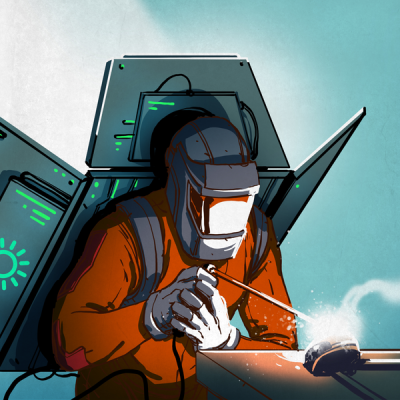It’s a brand new day as the Power Harvesting Challenge begins. This is the newest part of the 2018 Hackaday Prize and we’re looking for 20 entries who will each receive $1,000 and move onto the finals to compete for the top five spots, scoring cash prizes of $50k, $25k, $15k, $10k, and $5k.
Put simply, Power Harvesting is anything you can do that will pull some of the energy you need from a source other than wall-power or traditional battery tech. The most obvious power harvesting technologies are solar and wind. Ditch the battery in your doorbell for a solar panel, or turn your time-lapse camera rig into one that tops its battery with a tiny wind turbine. On the other end of the spectrum you could go nuts with chemistry and develop your own take on harvesting power from saltwater, or sip off the ambient RF waves all around us.
Every Idea Matters
We live in an amazing time as chip manufacturers have squeezed every low power trick out of their silicon dies that they possibly can. The Power Harvesting Challenge is the complement to those achievements: can we now squeeze as much energy out of non-traditional sources as possible to further reduce our energy footprints?
Ideas have a way of pollinating each other and growing into something new. Explore those threads of power harvesting inspiration you come across and show them off so others may benefit. What opportunities do you see in your everyday life? Can you remove from the power grid that reading light you use for 40 minutes each night? What kind of energy would a turbine on your rain downspout generate; is it enough to power a wireless rainfall sensor indefinitely? (After all, you only need those readings when it’s raining). Turn your shoes into power plants and report back on the amount of juice you see come in for any given number of steps.
A Bit of Inspiration
 Earlier this year, Hackaday’s own Sean Boyce took on a power harvesting project. He set out to build a solar-powered spot welder that charged supercapacitors using the sun’s energy. The resulting proof of concept works, and is entirely self-sufficient without the need to receive power from the grid. It’s a first rev and isn’t 100% practical, but his research points to practicality through more work on component choice and usage. Whether you need something like this or not, the design process, characterization of components, and testing he did is applicable to all power harvesting projects so check it out!
Earlier this year, Hackaday’s own Sean Boyce took on a power harvesting project. He set out to build a solar-powered spot welder that charged supercapacitors using the sun’s energy. The resulting proof of concept works, and is entirely self-sufficient without the need to receive power from the grid. It’s a first rev and isn’t 100% practical, but his research points to practicality through more work on component choice and usage. Whether you need something like this or not, the design process, characterization of components, and testing he did is applicable to all power harvesting projects so check it out!
Did you know there are doorbells that have no batteries in them? Well, kinda. The button you put next to your front door has a piezo element in it (a trick we saw starting about nine years ago). When you press the button it generates just enough juice to squawk out to the receiver — which is itself powered by a wall wart. How often does your doorbell ring? We’d love to see that receiver get some or all of its energy through power harvesting — that is low hanging fruit for an entry. Or, you could repurpose the button unit for other uses. Show us what you’ve got!
 Do you remember the battery-less HD video streaming demo that we covered last month? This falls into the category of serious research, but highlights the kind of wacky ideas that might just become reality. This works using backscatter, reflecting the radio waves in the space all around us. It injects an analog HD video signal into that backscatter which is picked up and decoded by a receiving nearby. The camera is meant to be mounted in a pair of glasses and is completely battery-free because it uses RF to power the camera sensors and backscatter system. It’s a great example of doing a lot with the power harvested and stored in a capacitor.
Do you remember the battery-less HD video streaming demo that we covered last month? This falls into the category of serious research, but highlights the kind of wacky ideas that might just become reality. This works using backscatter, reflecting the radio waves in the space all around us. It injects an analog HD video signal into that backscatter which is picked up and decoded by a receiving nearby. The camera is meant to be mounted in a pair of glasses and is completely battery-free because it uses RF to power the camera sensors and backscatter system. It’s a great example of doing a lot with the power harvested and stored in a capacitor.
Do It!
This is a fun area of electronics/physics to explore and you’ll learn a lot of interesting stuff just by trying. Our battery technology is slow to make big improvements, so let’s dream up some ways to take more of the effort off of those battery systems. Enter your project in the Power Harvesting Challenge now!



















“Put simply, Power Harvesting is anything you can do that will pull some of the energy you need from a source other than wall-power or traditional battery tech.”
Bioelectricity. Nickel-63.
Two words: Crystal Radio.
Should be able to do interesting things with that as a primer.
I have a toy-project in mind that just about might fit in this category (though it’s not neat, cool or inventive enough to actually win anything!) Too bad it takes 2-6 weeks for the parts to arrive from China.
Thermal gradient energy harvesting using excess attic heat to charge batteries in hot summer months.
Carnot says: “no es bueno!”
Peltier begs to disagree with Carnot, especially if there is a cold-water supply available.
Cold water supply maybe, but if you’re harvesting energy off the thermal gradient between the air in your attic and the air in your house you’ve effectively put a very inefficient tap on your own air conditioning, and you might just try using the electricity out of the wall directly!
Of course that would be useless. But often there is a thermal gradient between the attic (sun blazing on the roof) and the outside air. That could be used.
Tow a straight axel trailer, 6 microwave turntable motors, belts connected to the spinning axel & turntable motors, & wire.
BOOM.
Or you could use the force of the ocean waves near the undertow harnessed with gyroscopes with immense resistance.
✌️????????️.
Power is coming straight from the towing vehicles motor.
If only there were some kind of alternator already hooked up to the vehicle’s spinning power train, maybe even connected to an energy storage medium like a lead-acid battery to even out the spikes.
Most interesting I’ve come across in a while: using daily temp/pressure swings to lift weights and wind mechanical clocks.
https://hackaday.com/2018/02/25/mechanical-clocks-that-never-need-winding/
The Beverly clock has what amounts to a bellows and a two-way ratchet. I looked everywhere for a good estimate of how much energy it harvested in an average day, and I still got it wrong in the writeup. (Sigh.)
Anyway, the mechanism is necessarily big, but it could also be very lightweight. An interesting set of constraints. Go!
Tensile kite turbines are lightweight & scaleable harvesting designs, which are not necessarily big, as they can be folded like tents to aid transportation energy offsets.
Love the power harvesting challenge put forth in this article. Attracting a community of like-minded people from all vectors of life to chip away and reduce our reliance on and use of Earth sourced fuels to generate electricity.
I’ve seen many great ideas brought to live here.
Has anyone reading this post worked on, know of, or seen much in the way of “recovering” as much energy (in it’s many forms) as possible from our homes that could reduce overall energy useage to a point where solar, wind, thermal, waves/tides, ect could supply enough energy for a majority of the locations where humans populations live?
If so would you please post a text link of communities and/or related efforts?
Quick read thoughts for possible projects. Yes, this is from a “1st world” perspective and humanity could really benefit from ideas for those without current utility type services. Ideally the less earth sourced natural resources we use the more others can until they too are able to maintain a quality of life and begin (or implement while developing) transition to reusing all they can.
How many times do we move items in our homes/life that could potentially add small amounts of energy to local energy storage?
Perhaps something like the following:
1. Capture energy from opening/closing doors, windows, drawers of cabinets, et al? Perhaps not only the movement but also sudden stops at the end?
– know this would be a very small amount per individual action but there are many people already going through the motions and growing. A single drop of water is often overlooked and alone not very powerful until it joins other drops and together creates a waterfall or the power of the ocean.
2. Water and the small (piped) gravity powered waterfalls where we live, work and play.
– Recover a little of the energy used to provide flowing water into our homes, when gravity drains it from our homes.
– Possible collection from:
— Inline device(s);
— “micro dam(s)” within the house (ect) that open the gates once enough water is collected for gravity to pull the volume through an inline device and convert to electrical; or
— Something outside the pipe to collect a sort of induction based energy from the movement of water through the pipe?
PLS note I understand there are endless possibilities for generating and storing energy.
I’m confident there may always be a requirement for generating corporate scale power generation to support efforts requiring enormous amounts of energy. Such as leaving Earth orbit (BTW I’m happy on this planet as it is my favorite) and becoming a multiplanetary species among other major earth-based systems until we are able to realistically utilize more of our host stars power. I’m confident that most readers here understand all the earth based life and majority of stored energy came from our Sun.
All the best!
Klif
Use water flowing through four cross-wired coffee cans to power a neon bulb.
Does coffee still come in cans?
B^)
I have a ten year old here at home that surely could spare a few spaz units to reclaim and convert to watts via generators.
“Did you know there are doorbells that have no batteries in them?”
Of course! The house I grew up in was built in the 1870s, and had no electric wiring when it was built. It was built with a loud doorbell powered by a hand crank.
“You could go nuts with chemistry and develop your own take on harvesting power from saltwater”
Careful. There’s not much chemical energy in saltwater, but if you find a way of extracting some, more power to you (pun intended). However, please don’t put two dissimilar metals into saltwater and observe that you can produce voltage and current, and claim that you’ve therefore harvested energy from saltwater. You have made a chemical battery, which produces electricity by oxidizing an electrode. The energy produced by such a battery was originally put into the battery when the electrode was refined from ore. It’s not an energy source, but an energy storage device, and a very inefficient and wasteful one at that. For ages, kid’s science fair experiments have made “lemon batteries”, or “potato batteries”, or numerous other batteries with natural electrolytes. They do function, in the sense that the produce enough power to run a digital clock, or light an LED, or something similar. But the expensive and energy-intensive part of a battery was never the electrolyte, it’s the electrodes.
More generally, be aware of what has been done before. Free energy is all around us. It’s easy to find quirky sources of small bits of energy. The challenge is finding concentrated sources of energy that can be put to good use economically, with minimal environmental costs. Second best might be finding a quirky source of a small amount of energy that happens to be very well-matched to a task that would otherwise use significant conventional electric power or fossil fuels. Good luck!
“The challenge is finding concentrated sources of energy that can be put to good use economically, with minimal environmental costs.” “Second best might be finding a quirky source”
Honestly? An outdoor clothesline (in many climates, but not all). It displaces huge amounts of electrical energy that would be consumed by my dryer, more than offsetting the minimal energy used by my RPi, home sensors, etc. It’s also “quirky”, as it’s not used by many people, and has been banned and is still banned in ignorant communities – where hacking policy to allow an outdoor clothesline might be the best hack!
I like it! And like many of the great ideas, it’s an old one that was largely abandoned. In a similar vein, I mow my yard with a manual push reel lawn mower. Cheap, simple, no emissions, quiet, lets you smell the fresh cut grass without the odor of burned motor oil.
Nothing wrong with recycling the best older ideas!
No emissions?
https://www.quora.com/Do-human-farts-contribute-to-global-warming
What? Banned? A clothes line? In what crazy jurisdiction anybody can ban a clothesline? It is no danger, it does not emit noise or any other pollution.
I don’t have one because I live in a city apartment, so I often use dryer, at least for small stuff, which is time consuming to hang on an indoor drying rack.
California, no less!
Not everywhere, but in “communities” that require residents to contracts (CCRs) to live there.
Kanata, the western suburb of Ottawa, Ontario where many electronics and software business are located had this ban until Ontario wiped the ban out, province-wide. Here’s a good news story about the issue and energy use and potential savings.
https://toronto.ctvnews.ca/ontario-premier-lifts-outdoor-clothesline-ban-1.290136
Agreed about the difficulty of using an indoor rack, which I have used in winter.
I did post this clothesline example even though it’s a bit off-topic as one of beautiful simplicity, a goal of many hacks.
I do like the idea of this challenge (my post wasn’t intended to dismiss it) as much as it gets people (including me) thinking about what is truly wasted energy that can be converted to something useful. The discussion in this topic has already started to raise some interesting ideas.
This is my first topic and second post here. I have enjoyed the constructive posts on this site; it’s nice to see that kind of discussion. Thanks to all!
Notable the need for efficiency in energy conversion outlays the need for new energy sources.
Find a way of harnessing the waste heat from ICE, or other insanely wasteful energy transformer with a considerable heat output, either by boiling water and running a small (micro actually), likely Tesla type or more conventionally constructed, steam turbine. Close the cycle and try to release as little heat as possible in the environment, when that is achieved, the needs for additional energy sources will be highly minimized.
I’m moving at the end of the summer to a house that’s near-ish some high voltage power lines – maybe 1/2 mi, 3/4 km. I wonder what I would need to get a trickle out of them.